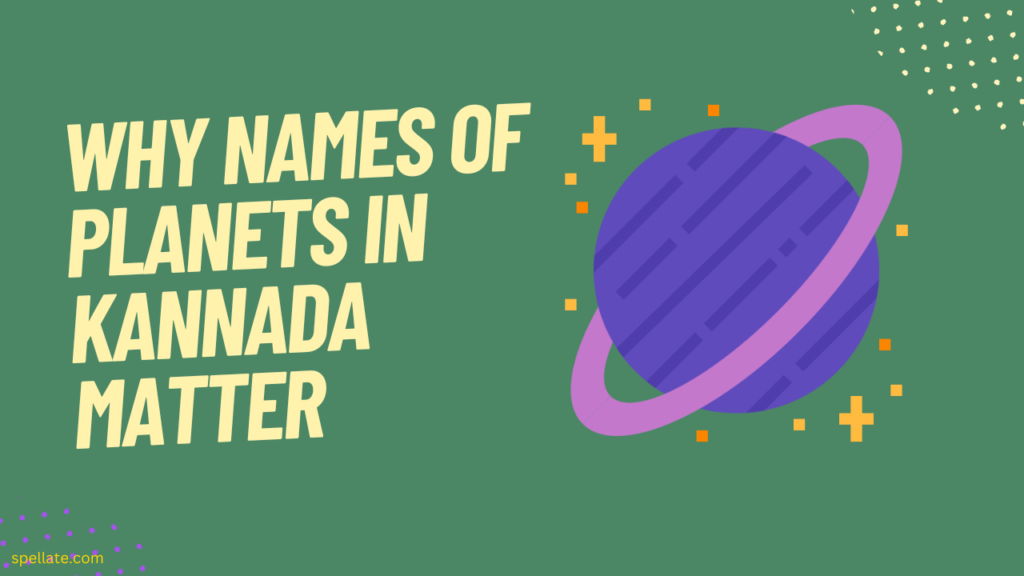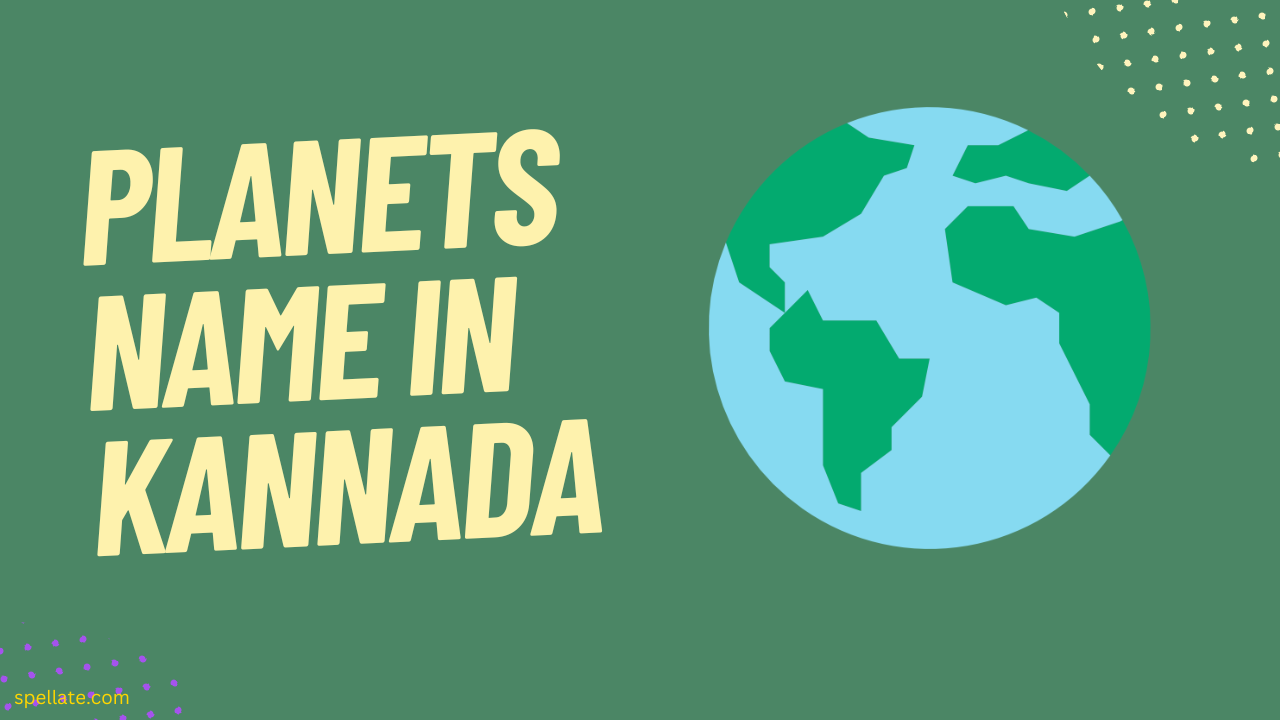The universe is a vast and awe-inspiring expanse, filled with galaxies, stars, and planets. Among these celestial entities, planets have always intrigued humans due to their unique characteristics, movements, and potential for life. Different cultures around the world have had their own ways of identifying and naming these planets, derived from mythology, observational astronomy, and ancient lore. The Kannada language, with its rich heritage and history, is no exception.
Kannada, primarily spoken in the southern Indian state of Karnataka, has deep roots that stretch back over a millennium. It boasts a unique blend of Dravidian linguistic structures and a vibrant literary tradition. Just as in other cultures, the names of planets in Kannada reflect a combination of observational science and mythology.
This article aims to introduce readers to the 9 planets name in Kannada, providing both their linguistic origins and cultural significance. Whether you are a student, a linguist, an astronomer, or just someone curious about different cultures, this guide promises a journey through the Kannada cosmos that you won’t forget.
- 9 Planets name in Kannada Language
- 1. ಬುಧ (Budha) – Mercury:
- 2. ಶುಕ್ರ (Shukra) – Venus:
- 3. ಭೂಮಿ (Bhūmi) or ಪೃಥ್ವಿ (Prithvi) – Earth:
- 4. ಮಂಗಳ (Maṅgaḷa) – Mars:
- 5. ಗುರು (Guru) or ಬೃಹಸ್ಪತಿ (Bṛhaspati) – Jupiter:
- 6. ಶನಿ (Shani) – Saturn:
- 7. ಯುರೇನಸ್ (Yurēnas) – Uranus:
- 8. ನೆಪ್ಟ್ಯುನ್ (Nepṭyun) – Neptune:
- 9. ಪ್ಲೂಟೋ (Plūṭo) – Pluto:
- Why planets name in Kannada matter
- Final Thoughts
- FAQs
9 Planets name in Kannada Language

Planets hold an enchanting allure, beckoning us to explore the vast cosmos and unravel its mysteries. In the Kannada language, these celestial bodies are endowed with names that reflect both their significance and cultural context. Let’s take a glimpse into the world of astronomy in Kannada and discover the beauty of the nine planets. Below are the 9 planets name in Kannada language
1. ಬುಧ (Budha) – Mercury:
Linguistic & Mythological Roots: In Kannada, as in several other Indian languages, “Budha” refers to Mercury. The term has its roots in Indian astrology and Hindu mythology. Budha, in Hindu mythology, is the deity representing the planet Mercury. He is considered the god of wisdom, commerce, and communication. He is also associated with Wednesday; in fact, the word for Wednesday in Kannada is “ಬುಧವಾರ” (Budhavāra).
Astronomical Aspects: Mercury is the closest planet to the Sun. Due to its proximity, it’s not easily visible most of the time, except during dawn or dusk. Its rapid movement around the Sun led it to be named after the swift messenger god in various cultures.
2. ಶುಕ್ರ (Shukra) – Venus:
Linguistic & Mythological Roots: “Shukra” is the name for Venus in Kannada and many other Indian languages. In Hindu mythology, Shukra was the teacher of the demons and the author of an important Sanskrit work on astrology. Additionally, he’s the presiding deity of the planet Venus. Shukra is also associated with Friday; in Kannada, Friday is called “ಶುಕ್ರವಾರ” (Shukravāra).
Astronomical Aspects: Venus is the second planet from the Sun and is Earth’s closest planetary neighbor. Known as the ‘morning star’ or ‘evening star,’ Venus is the brightest celestial body in the night sky after the Moon. Its brilliant shine is due to the reflection and scattering of sunlight by its thick atmosphere filled with carbon dioxide and clouds of sulfuric acid.
3. ಭೂಮಿ (Bhūmi) or ಪೃಥ್ವಿ (Prithvi) – Earth:
Linguistic & Mythological Roots: In Kannada, Earth can be referred to as “Bhūmi” or “Prithvi.” Both names have deep mythological significance in Hindu traditions. Bhūmi is often personified as the goddess of the Earth in Hinduism, and she is the consort of Lord Vishnu. Similarly, “Prithvi” is also a goddess and represents the Earth. She plays a significant role in various Hindu scriptures and stories.
Astronomical Aspects: Earth is the third planet from the Sun and the only known celestial body to support life. It has a unique atmosphere composed of nitrogen, oxygen, and other elements, which allows for the existence of water in liquid form – a critical ingredient for life as we know it. The Earth rotates on its axis, leading to the cycle of day and night, and orbits around the Sun, resulting in the changing seasons.
4. ಮಂಗಳ (Maṅgaḷa) – Mars:
Linguistic & Mythological Roots: “Maṅgaḷa” is the Kannada term for Mars. In Hindu mythology, Maṅgaḷa is the god of Mars and represents war, aggression, and vitality. The color red, synonymous with Mars due to its distinct reddish appearance, is also associated with these qualities. In Kannada, Tuesday is referred to as “ಮಂಗಳವಾರ” (Maṅgaḷavāra), connecting the day with the planet.
Astronomical Aspects: Mars is the fourth planet from the Sun and is often referred to as the ‘Red Planet’ due to the iron oxide (rust) prevalent on its surface, giving it a reddish appearance. With conditions less hospitable than Earth, Mars is of significant interest in the search for life beyond our planet, especially with its polar ice caps and evidence of ancient flowing water.
5. ಗುರು (Guru) or ಬೃಹಸ್ಪತಿ (Bṛhaspati) – Jupiter:
Linguistic & Mythological Roots: Jupiter in Kannada is known both as “Guru” and “Bṛhaspati.” In Hindu tradition, Bṛhaspati is the teacher of the gods, and the term “Guru” translates to “teacher” or “master” in English. Bṛhaspati is also considered the deity of the planet Jupiter. The day Thursday is linked to Jupiter and is named “ಗುರುವಾರ” (Guruvāra) in Kannada.
Astronomical Aspects: Jupiter is the largest planet in our solar system and is primarily composed of gas. It is known for its strong magnetic field, numerous moons, and the iconic Great Red Spot – a giant storm larger than Earth itself. Its massive size and gravitational pull have played a major role in shaping the solar system.
6. ಶನಿ (Shani) – Saturn:
Linguistic & Mythological Roots: Saturn is referred to as “Shani” in Kannada. Shani is a significant deity in Hindu astrology and represents discipline, responsibility, and justice. He is often depicted as a dark figure riding a chariot and carrying a sword. Shani is feared and revered for the influence he is believed to exert on individuals’ lives. Saturday, or “ಶನಿವಾರ” (Shanivāra) in Kannada, is associated with this planet.
Astronomical Aspects: Saturn is the sixth planet from the Sun and is renowned for its beautiful ring system. These rings are made primarily of ice particles with a smaller fraction of rocky debris and dust. Saturn is a gas giant like Jupiter, and it’s known for its rapid rotation and hexagonal storm at its north pole.
You May Also Like
7. ಯುರೇನಸ್ (Yurēnas) – Uranus:
Linguistic & Mythological Roots: Unlike the inner planets, Uranus doesn’t have a traditional Kannada name deeply embedded in Indian mythology since it was discovered later in human history, specifically in 1781. Hence, the name “Yurēnas” is a transliteration of the English name.
Astronomical Aspects: Uranus is unique for its sideways rotation, essentially rotating on its side relative to its orbit. It’s a gas giant, and its atmosphere is primarily composed of hydrogen and helium. This planet has a pale blue color due to the presence of methane in its upper atmosphere, which absorbs red light and reflects blue-green light.
8. ನೆಪ್ಟ್ಯುನ್ (Nepṭyun) – Neptune:
Linguistic & Mythological Roots: Like Uranus, Neptune’s existence wasn’t known to ancient Indian astronomers, as it was discovered in the 19th century, in 1846, to be specific. Therefore, its name in Kannada is a direct transliteration from English.
Astronomical Aspects: Neptune, the eighth planet from the Sun, is known for its striking deep blue color. It’s a gas giant and has a similar composition to Uranus. Neptune possesses the strongest winds in the solar system, reaching speeds of up to 2,100 kilometers per hour. The planet is also known for its dark spots, which are storm systems similar to Jupiter’s Great Red Spot.
9. ಪ್ಲೂಟೋ (Plūṭo) – Pluto:
Linguistic & Mythological Roots: Though Pluto is no longer classified as a planet by the International Astronomical Union, it was traditionally considered the ninth planet. Discovered in 1930, its name in Kannada is a transliteration of the English name.
Astronomical Aspects: Pluto is a dwarf planet located in the Kuiper Belt, a region beyond Neptune filled with small icy bodies. It has a heart-shaped glacier known as the Tombaugh Regio, named in honor of its discoverer, Clyde Tombaugh. The New Horizons spacecraft, which flew by Pluto in 2015, revealed a diverse landscape with mountains, valleys, and plains.
Why planets name in Kannada matter

The planets name in Kannada, or in any language, offers much more than mere terminologies. Here’s why they matter:
Cultural Significance: The planets name in Kannada, especially those rooted in mythology, provide insights into the region’s cultural, religious, and historical background. They reflect ancient beliefs, stories, and the manner in which the cosmos was perceived.
Linguistic Richness: Each language presents a unique way of understanding and interpreting the world. The names in Kannada exemplify the linguistic richness and diversity of the language, offering different phonetic, morphological, and semantic nuances than other languages.
A bridge between the Past and Present: Traditional names for planets provide a bridge between ancient astrological beliefs and modern scientific understanding. For instance, the attributes associated with a planet in myths might be related to its astronomical features or its visual appearance in the sky.
Educational Value: Introducing planets Kannada names in local education helps foster a sense of identity and pride among the younger generation. It makes the subject matter more relatable and relevant to their cultural context.
Preservation of Identity: As globalization continues to spread, there’s a risk of local languages and cultures being overshadowed. By emphasizing and using native terms, there’s an active effort to maintain and celebrate linguistic and cultural uniqueness.
Holistic Understanding: In many cultures, including that of Karnataka (where Kannada is spoken), planets have astrological significance. Understanding the planets names in Kannada and their associated stories can offer a holistic perspective, encompassing both scientific and cultural viewpoints.
Final Thoughts
In conclusion, the Kannada naming of planets is an interesting aspect of language and culture. It reflects the rich heritage and deep connection that Kannadigas have with the celestial bodies. The unique names given to each planet in Kannada not only add a touch of local flavor but also serve as a reminder of the importance of preserving indigenous languages.
By appreciating and promoting the use of planets name in Kannada, we can contribute to the preservation and celebration of Kannada culture. So let us embrace these beautiful and meaningful names and continue to explore the wonders of our universe through the lens of Kannada language.
FAQs
How many planets are there in our solar system, and do they all have Kannada names?
There are eight officially recognized planets in our solar system. Yes, each of them has a corresponding name or representation in Kannada.
How do you say sun in Kannada?
The word for sun in Kannada is Surya.
What is the name of the moon in Kannada?
The moon is called Chandra in Kannada.
Does the moon have any other names in Kannada?
In addition to Chandra, the moon can also be called as indu or Vidyut.
